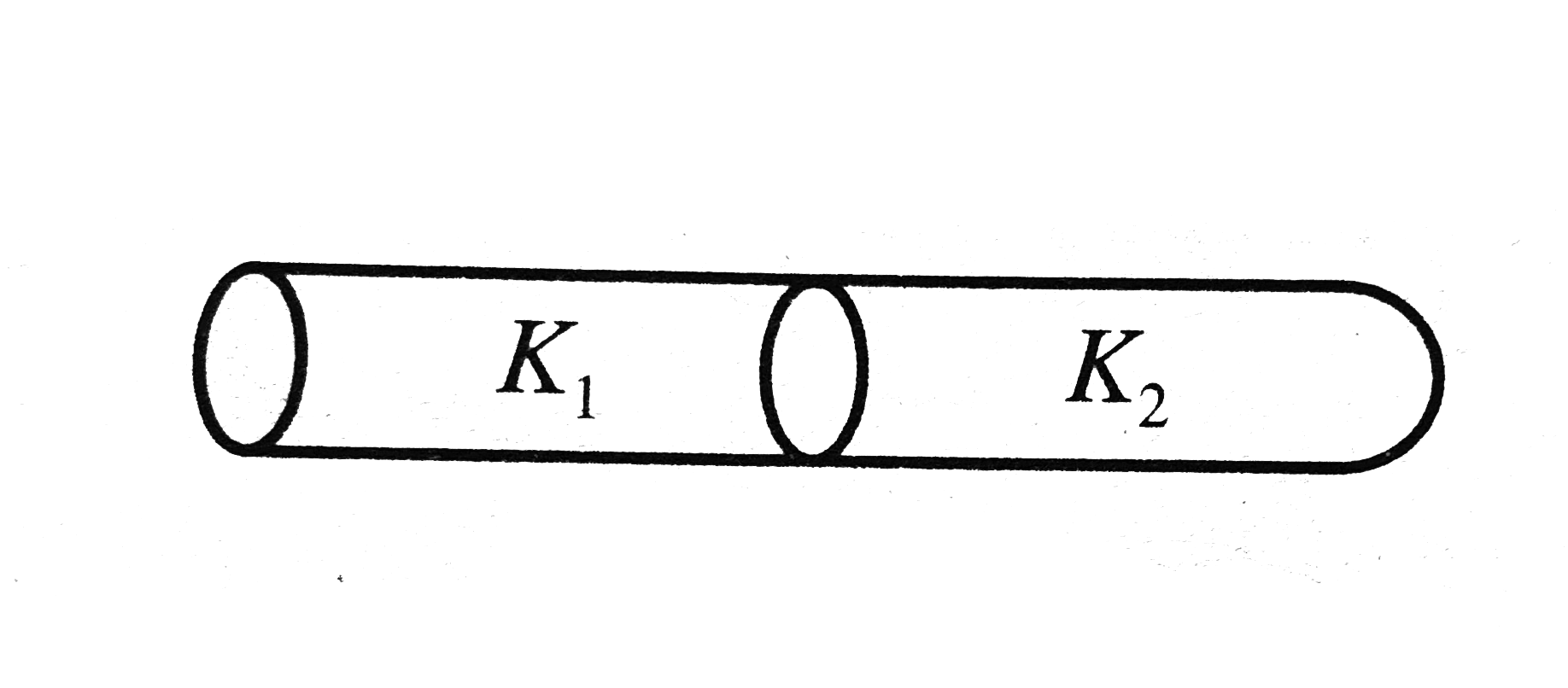Two rods of the same length and diameter, having thermal conductivities K1 and K2, are joined in parallel. The equivalent thermal conductivity to the combinationk is
K1K2K1+K2
K1K2
K1+K22
√K1K2
The correct Answer is:C
To find the equivalent thermal conductivity k of two rods joined in parallel with thermal conductivities K1 and K2, we can follow these steps:
1. Understanding the Setup:
We have two rods of the same length L and diameter d which are joined in parallel. The thermal conductivities of the rods are K1 and K2.
2. Heat Resistance Calculation:
The heat resistance R for a rod can be expressed as:
R=LK⋅A
where A is the cross-sectional area of the rod. Since both rods have the same diameter, their cross-sectional areas are equal.
3. Resistance of Each Rod:
For the first rod:
R1=LK1⋅A
For the second rod:
R2=LK2⋅A
4. Equivalent Resistance in Parallel:
When resistances are in parallel, the equivalent resistance Req can be calculated using:
1Req=1R1+1R2
Substituting the expressions for R1 and R2:
1Req=K1⋅AL+K2⋅AL
5. Simplifying the Equation:
Factoring out AL:
1Req=AL(K1+K2)
Thus:
Req=LA(K1+K2)
6. Finding Equivalent Thermal Conductivity:
The equivalent thermal conductivity Keq can be defined as:
Req=LKeq⋅A
Setting the two expressions for Req equal to each other:
LKeq⋅A=LA(K1+K2)
7. Solving for Keq:
Canceling L and A from both sides:
Keq=K1+K2
Final Result:
The equivalent thermal conductivity Keq for the two rods joined in parallel is:
Keq=K1+K2
We have two rods of the same length L and diameter d which are joined in parallel. The thermal conductivities of the rods are K1 and K2.
The heat resistance R for a rod can be expressed as:
R=LK⋅A
where A is the cross-sectional area of the rod. Since both rods have the same diameter, their cross-sectional areas are equal.
For the first rod:
R1=LK1⋅A
For the second rod:
R2=LK2⋅A
When resistances are in parallel, the equivalent resistance Req can be calculated using:
1Req=1R1+1R2
Substituting the expressions for R1 and R2:
1Req=K1⋅AL+K2⋅AL
Factoring out AL:
1Req=AL(K1+K2)
Thus:
Req=LA(K1+K2)
The equivalent thermal conductivity Keq can be defined as:
Req=LKeq⋅A
Setting the two expressions for Req equal to each other:
LKeq⋅A=LA(K1+K2)
Canceling L and A from both sides:
Keq=K1+K2
The equivalent thermal conductivity Keq for the two rods joined in parallel is:
Keq=K1+K2
Topper's Solved these Questions
Similar Questions
Two identical metal wires of thermal conductivities K1 and K2 respectively are connected in series. The effective thermal conductivity of the combination is :
View SolutionTwo plates ofthe same area and the same thickness having thermal conductivities k1 and k2 are placed one on top of the other. Show that the thermal conductivity of the composite plate for conduction of heat is given by
k=2k1k2(k1+k2)
View Solution
Knowledge Check
Two rods of the same length and diameter having thermal conductivities K1 and K2 are joined in parallel. The equivalent thermal conductivity of combination is
AK1K2K1+K2B(K1+K2)CK1+K22D√K1K2Two rods of the same length and diameter having thermal conductivities K1 and K2 are joined in parallel. The equivalent thermal conductivity of combination is
AK1K2K1+K2B(K1+K2)CK1+K22D√K1K2Two rods of equal length and diameter but of thermal conductivities 2 and 3 unites respectively are joined in parallel. The thermal conductivity of the combination is:
A1B1.5C2.5D5
A slab consists of two layers of different materials of the same thickness and having thermal conductivities K1 and K2. The equivalent thermal conductivity of the slab is
View SolutionA slab consists of two parallel layers of two different materials of same thickness having thermal conductivities K1andK2. The equivalent conductivity of the combination is
View SolutionTwo rods of equal length and diameter have thermal conductivity 3 and 4 units respectively. If they are joined in series, the thermal conductivity of the combination in the given units would be
View SolutionThree rods of same dimension are joined in series having thermal conductivity k1 , k2 and k3. The equivalent thermal conductivity is
View Solution Statement I: Two solid cylindrical rods of identical size and different thermal conductivity K1 and K2 are connected in series. Then the equivalent thermal conductivity of two rods system is less than that value of thermal conductivity of either rod.
Statement I: Two solid cylindrical rods of identical size and different thermal conductivity K1 and K2 are connected in series. Then the equivalent thermal conductivity of two rods system is less than that value of thermal conductivity of either rod.
Statement II: For two cylindrical rods of identical size and different thermal conductivity K1 and K2 connected in series, the equivalent thermal conductivity K is given by 2K=1K1+1K2
View Solution
